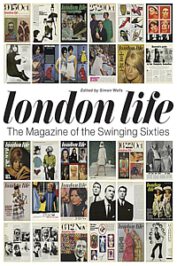A so far unparalleled team of talented artists, publishing pros and design specialists in their respective fields, like Peter Akhurst, Jean Shrimpton, David Hockney, and regular contributors such as Joe Meek, Eric Burdon, and Marc Bolan for a short while were all connected to England’s probably most advanced magazine of the 1960s, London Life.
 It provided just the right amount of space and sections to cover all the subjects of importance to the VIPs, the not so important persons and those interested in the goings-on in London. Starting a magazine of that size and expensive production, would hardly had made sense in any other English city. As most things of importance, arts, music, literature and mostly fashion, talk of the town, events, exhibition openings combined with excellent photography and gossip happen right there, sometimes only a few blocks away from the magazine’s editorial office.
It provided just the right amount of space and sections to cover all the subjects of importance to the VIPs, the not so important persons and those interested in the goings-on in London. Starting a magazine of that size and expensive production, would hardly had made sense in any other English city. As most things of importance, arts, music, literature and mostly fashion, talk of the town, events, exhibition openings combined with excellent photography and gossip happen right there, sometimes only a few blocks away from the magazine’s editorial office.
The over sized hardback book at hand is the first title to present a substantial portrait of the outstanding publication.
Many celebrities would join the ranks of staff writers by giving their opinion on anything from arts, favorite restaurants, new bands or shoe trends. Contemporary and avant-garde design fashion and style played an important role in the genesis of this extraordinary product, as all details for layout, typesetting, paper quality of individuals sections were carefully prepared in advance.
The Swinging Sixties in England are hardly better documented and portrayed than in London Life. While that fast-paced, thrilling and extraordinary lifestyle and the ability to take part in it were reserved to just very, very few young people living in the vicinity of London who also had the funds to consume all that was advertised, the capital’s promises somehow were promoted even more. However, the very photographic “proof” of what was possible also made London Life some sort of wish list portraying some exotic venue one should visit or make one’s home, one day, particularly if one lived in a small industrial English town, world’s apart from that wonderland.
Editor and illustrator Mark Boxer, very well connected with the inventive powers at work in London, in 1965 was chosen by the publishers of the somewhat shaken magazine Tatler to create a fresh and contemporary title that would appeal to both the aficionados of design and the young creative scenes in art, fashion and journalism, while celebrating the many venues and events only London could offer.
Putting together a group of specialists who would include (24-year-oldd) David Puttnam, David Hillman, Peggy Roche, Peter Knapp and several gifted photographers – as the magazine was mostly a visual pleasure – London Life debuted on October 7, 1965.
The title would be at the shops weekly, which would mean very close deadlines for the entire team. Its “The Week Ahead” section would cover all kinds of cultural events from upcoming Saturday to Friday. Thereby establishing “… a template that future guides to the capital would later follow,” says Wells. Even with today’s technology, such a 7-day schedule would be extremely tight and back in the day, with everything typed and layout completed manually, it was an intense workload.
Unfortunately, we will never know how long the mag would have been continued or what ideas could have been realized without interference from the publication’s management; as it cut down the editorial budget costs by 50% after only six issues, making production with planned design and care almost impossible. Besides, little budget remained for models, photographers and writers. In the end, Boxer, Hillman, Puttnam and others, as well external contributors left the magazine, that now was put together without directors; it would quickly lose a lot of its original design and magic.
This series of events led to the very early termination of the enterprise, and after 15 months of circulation London Life folded.
“While you’ll find the sixties referenced continually these days, few artifacts have endured with any believable integrity. Nonetheless, within the blizzard of ephemera that the era spawned, the magazine London Life remains the truest reflection of that amazing period.”
Editor Simon Wells, well-known for a string of books on other popular culture subjects and the Sixties, in particular, provides a short, but interesting introduction that includes all the major dates and personnel that took part in that experiment 55 years ago. Instead of going on forever about this or that article, photographer or edition, he wisely cut his own contribution short and lets the magazine speak for itself on the next 170 high-quality (and, yes, yellowing, as these are copies of vintage editions) reproduction pages that come in their original size.
Thanks to the combination of excellent prints that have their emphasis on large photographs and collages, owed to the great layout, together with Wells’ text a very vivid impression of this gorgeous but unfortunately short-lived magazine and the exiting mid-sixties London resurfaces. Luckily, a facsimile of the famous “Full colour fold-out map of Swinging 60s London” is included.
A great gem for any popular culture bookshelf and fans of the British Sixties.
Review by Dr. A. Ebert © 2020
Simon Wells (ed.) London Life. The Magazine of the Swinging Sixties. Omnibus Press, 2020, 176 p.
